The worried housekeeper found the owner on the floor of the greenhouse: "He was lying at the foot of ... orchids. Air roots similar to tentacles no longer hung freely in the air. Having come closer, they formed, as it were, a ball of gray rope, the ends of which tightly clasped his chin and neck ..."
G. Wells. Flowering of a strange orchid.
How and when the idea came to me to write about carnivorous plants, I don’t know. Apparently she was not herself, otherwise where would such strange desires come from. The article started three times. If it still doesn't work, I'll leave. In general, I write about predator plants ...
What do we, ordinary people, know about plants that feed on living organisms? Oh, we know a lot ... For whom Gerber Wells wrote his fantasy stories about killer plants? For whom does the entire American film industry work? For us. All for us.
So, predatory plants necessarily eat anyone who fell into their bloodthirsty paws: flies, chickens, dogs, people, horses, elephants ... They live in the strangest places - in cold swamps, in dense forests, in rich greenhouses, etc. .d. etc…
In 1970, the Brazilian naturalist Mariano da Silva discovered in the rainforest on the border with Guyana a palm-like carnivorous tree that fed on broad-nosed monkeys and sloths. The tree fed on what attracted monkeys to itself with a particularly appetizing smell. Inhaling it with dull pleasure, the animals fell into a trance and climbed up the trunk, higher and higher ... where the last supper came for them: the leaves of the crown closed over careless animals, so that they turned out to be wrapped in a dense cocoon. So tight that the drugged monkeys did not have time to make a sound or a sob - they died in complete silence.
According to da Silva, for three days the green monster digested its prey, and then, as is customary with a vampire tree, "spit" the gnawed bones on the ground.
To Nicaragua such a monster encountered George Dunstan, wandering through the thicket in search of rare plants. His dog almost became a victim of a predator. He wandered in search of rare plants in the rainforest, accompanied by a small dog. Distracted, Dunstan suddenly heard the howls and moans of his dog. Then death rattles were heard. The owner rushed to help faithful dog and caught a terrible picture. He saw a dog entwined with a whole network of roots and a long black liana, strangling the dog. The black creeper had already pierced the skin of the animal and sucked out the blood. With great difficulty, the naturalist cut the living web and freed the dog. Local residents later reported that the dog got off lightly: usually a black vampire creeper drinks all the juices from a living body in the blink of an eye. Devouring an animal lasts no more than five minutes. This tree is called the "snake tree" by the natives.
I remembered a movie, old, English, sort of. there in flower shop a flower was brought, and the seller accidentally discovered that he liked blood. He began to feed him with his blood, the flower grew and he needed more and more blood. He began to feed him with body parts of people, first those that he found (corpses), and then he himself began to kill. The flower grew large and ate his girlfriend, the guy wanted to kill the flower, climbed into it with a gun, but the flower ate it too. And then the flowers blossomed like a sunflower with the faces of those it had devoured.
That's how creepy and interesting they are.
Following the lead of my inquisitive mind, I got myself such a Tamagotchi ... A flycatcher has been living in my house for almost a year now. He doesn’t eat flies, he’s probably embarrassed, but he regularly entertains his son - he comes to her and touches the traps with his finger: if you touch one trap twice in a row, it slams right before your eyes. I just want to say to her - “aaaaaaaaaaaaaaaaaaaaaaaaaaaaaaaaaaaaaaaaaaaaaaaaaaaaaaaaaaaaaaaaaaaaaaaaaaaaaaaaaaaaaaaaaaaaaaaaaaaaaaaaaaaaaaaaaaaaaaaaaaaaaaaaaaaaaaaaaaaaaaaaaaaaaaaaaaaaaaaaaaaaaaaaaaaaaaaaaaaaaaaaaahhhhhhhhhhhhhhhhhhhhhhhhhhhhhhhhhhhhhhhhhhhh The child touches them all and leaves with a sense of accomplishment. But she doesn’t immediately open them back - sometimes only in the morning, and sometimes (apparently when her hands after eatingnot washed ) in a few days.
carnivorous plants in the house
Today, more than 500 species of predator plants are known. For growing at home, the Venus flytrap, various sundews, medium-sized types of nepentes, tropical types of fatworts and most sarracenia are most suitable.
Rod Rosyanka - one of the most numerous. It has over 90 species. They are distributed throughout the globe, but most of them in Australia and New Zealand. On the sphagnum swamps of the temperate zone, inconspicuous round-leaved sundews grow. Liquid droplets on leaf hairs used to be mistaken for dew (hence the name). Subsequently, it turned out that this is a special (sticky and caustic) liquid that attracts insects.
The sundew leaf is a sticky trap. It is covered with tentacles, which consist of a glandular head and legs - a conducting system. At one time it was believed that insects simply stick to the mucus, but recently scientists have isolated the alkaloid coniine from the sundew juice, a substance that has a paralyzing effect. In response to irritation, the leaf slowly curls up into a "cam". The sundew digests the insect for several days, after which the leaf straightens again, and the tentacles unbend.

Representatives of tropical species of this plant are much larger. For example, the Australian sundew giant - its stem can reach a meter in length, and large trapping leaves resemble a giant web with a huge trapping surface. Usually grown in home greenhouses cape sundew- with vertically arranged narrow leaves.
In Central America , in her virgin tropical forests, also grow their monsters of the green world, feeding on living creatures.
One of them looks like a big fat cactus, but it is not covered with thorns, but with real daggers. For the time being they are motionless. However, a hardly careless traveler will pass between these green knives, as they instantly and without any warning clamp the victim and pin it to the trunk. Here it is the main carnivorous organ. Living daggers pierce a person, blood flows, so necessary for a vampire plant.
In the fall of 2000, 63-year-old American Elsa Scheider from the town of Orlando Beach, State Florida, sunbathing on a sun lounger in her backyard. Through her half-sleep, she felt something dig into her back.
"I thought it was some kind of insect," she told a Weekly World News correspondent. "But when I turned around, I saw a long green stalk crawling over my bathing suit." Mrs. Shader tried to throw off the plant, but the sprout stuck tightly into the fabric of the swimsuit. A moment later, a sharp pain pierced her body. She saw her own blood pulsing along the stem like a medical tube.
At heart-rending cries, the old woman's nephew, who had come to visit, ran out of the house. He managed to rip the vampire plant from his aunt's back. The offspring made a disgusting chomping sound and... quickly rolled away. Botanists from the University of Florida, whom Elsa turned to for advice, were quick to reassure her. carnivorous plants and indeed have recently settled in some US states. True, so far they were fed exclusively by flies and beetles, in extreme cases, frogs.
They live underground, on the surface there is only a small yellow flower. Outwardly, it resembles a harmless snapdragon and serves as a nose for the plant. Sensing a tasty insect nearby, he gives a signal underground. From there, a long tenacious tentacle instantly jumps out and sucks in prey. However, so far no one has noted cases of a plant attacking a more or less large animal, and even more so a person.
However, the old woman stubbornly stands her ground. “I’m lucky that at that moment I didn’t sleep. Otherwise, there wouldn’t even be anyone to bury,” she says. Since the day of the attack, the pensioner has not slept normally for a single night, she was tormented by insomnia and nightmares. She's afraid to even look at backyard, despite the fact that a caring nephew tore out a malicious plant with a root and burned it. Got Mrs. Shader and all the neighbors, showing them a hole in a bathing suit...
Experts believe that the old woman most likely lost her mind, and she imagined the whole incident. But pesticide sellers are ready to carry it on their hands, since the demand for their products in Orlando Beach is over recent weeks has grown significantly. As it turned out, the predatory snapdragon grows in the town on almost every lawn, and many decided to get rid of it right there. That being said, just in case...
Genus Dionaea includes only one type - Dioneae muscipulata, or Venus flytrap. The flycatcher develops a rosette of leaves gathered around a long peduncle with several large white flowers. The leaf blades are divided into two rounded valves, located at an angle to each other, with long strong teeth along the edges. When the halves of the leaf close together, a real trap is formed. Three sensitive hairs on the flaps actuate the trap. The powerful electrical impulse that causes it to close comes from the base of the plant only if the insect touches two of them. This happens within 1/5 of a second. The trap is kept in this state for at least 40 hours. And if something inedible "misses" or gets in, the leaf will open again in half an hour.

Advice: The plant forms underground pseudobulbs, so it can disappear in the winter and start growing again in the spring.
But this is terribly interesting:
- The dimensions of the Nepenthes pitcher trap, one of the most large species insectivorous plants of the Aristolochia family, allows him to catch rats and small birds.
- One of the enzymes secreted by nepenthes is nepenthesium, which decomposes prey proteins into amino acids. These compounds provide the plant with nitrogen, which is often deficient in its habitats in the humid tropics.
- Insect exoskeletons are another potential source of nitrogen. They are completely composed of a practically indestructible substance - chitin. However, Nepenthes can secrete an enzyme capable of dissolving this material as well.
- Many carnivorous plants have "spring" valves that are activated by electrical impulses generated by the plant itself.
- The length of the trapping leaves-jugs of sarracenia reaches a meter.
Along the coast North America growing Sarracenia purpurea, belonging to the family of the same name. Sarracenia jugs are modified leaves growing from a rhizome. Emerald, covered with a dense network of raspberry veins, exuding sweet juice, they resemble fabulous flowers. Sometimes the tube-leaves lie half-lying on the surface of the earth, resembling a rising cobra. Their length varies - from 3.8 cm to Australian cephalothus up to 60 cm Sarracenia yellow . On each trapping leaf there is a kind of "platform", landing on which insects can move only in one direction - towards the mouth of the jug. There is so much nectar released that it flows down the grooves along the entire leaf tube. Top part the cavity is covered with sharp hairs directed downwards, allowing the victim to easily slide to the bottom, but not letting him back. Sometimes tree frogs are found in the tubes of sarracenia. Birds use them as feeders, getting more live prey. In the last century, gardeners bred many forms of sarracenia, differing in the shape and color of the leaves.

In tropical Asia, the Seychelles, Madagascar, and Northern Australia, the most powerful of all "predators" live - representatives genus Nepenthes. They can also grow in the mountains - at an altitude of up to 2000 m, and on the edge of the forest, and even in the surf zone. This liana most often settles on tree trunks, wrapping them around tens of meters in height and bringing narrow inflorescences to the light.

My inquisitive botanical mind has long insisted on acquiring Nepenthes - it is also an interesting thing. His traps are like jugs. Some come with a lid. The other day I saw one in flowers from Alla. A dog costs 900 rubles. You need to find where they give cheaper and get yourself. I read here on one forum that people feed them chicken. Neighing. They somehow eat insects in nature, which, with drunken eyes, climb into such a jug - they get there into the liquid that the jug produces, akin to gastric juice. They don't eat chicken. Can not. She does not fit into a jug. In the literature, they write that Nepenthes eat well and quickly. They have a society of pure pitchers.
The Nepenthes leaf consists of three parts. At the base is a wide plate that supports photosynthesis. The middle part is endowed with sensitivity, enabling the plant to wrap itself around the leaves of trees. And, finally, the apical one - a jug with a lid - for catching insects. The jugs are painted in bright colors: red, milky white and colored with a spotted pattern. Above the mouth is a fixed lid that protects the contents of the jug from rainwater and serves as a landing site for insects. The prey, attracted by the color, smell and nectar, slides into the jar, as its inner surface is very slippery. Even insects that can move on vertical glass are not kept here. Once in a liquid containing enzymes and acids, and within 5-8 hours, the prey is completely digested. Only the chitinous cover remains. However, Nepenthes can secrete an enzyme that can even dissolve chitin.
Along the banks of fresh water bodies, on damp soil, there are upright nepenthes with side shoots creeping along the ground. The jars of such plants are hidden in the grass. They can hold up to 1-2 liters of liquid, which gets up to several hundred insects, and sometimes rats and small birds. in rooms and winter gardens most commonly cultivated nepenthes winged. Also of interest are nepenthes truncated and nepenthes Rafflesi - with large purple-spotted jugs.
Zhiryanki- got its name from the Latin pinguis - fat, because of the fleshy, shiny, juicy leaves, collected in a large rosette. The upper surface of the leaves is densely covered with glands - on long and short legs. The former secrete sticky sugary mucus to attract insects, the latter secrete digestive juice to digest prey. The insect sticks to the surface of the sheet, after which it slowly twists and remains in this state for about a day. In summer, a long peduncle with a purple flower, similar to an elegant butterfly, grows from the middle of the rosette. The most common indoor plant Moran's butternut squash from Mexico and zhiryanka agnaya.
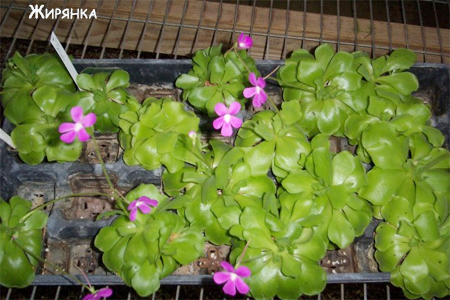
CARE RULES:
All "predators" are photophilous and love well-ventilated rooms.
All require high humidity - 80-90%. In this case, you should not spray the plants and even more so wash them in the shower.
Temperature regime: in summer - 22-26ºС, in winter - at least 10ºС.
Predator plants should be watered with warm, settled, soft, slightly acidified water. Preferably - rain or melt, adding a little acetic acid to it. The irrigation regime is also important: in summer, the soil should be constantly moist, but in winter, watering is reduced to 1 time in 2 weeks.
So that the roots do not rot in a pot, good drainage is necessary: a layer of 1-2 cm of expanded clay or broken ceramic chips. All carnivorous plants, with the exception of Nepenthes, need acidic soil, peat is best.
In season active growth from - March to September - carnivorous plants can be fed once a month with liquid mineral fertilizers(for succulents or azaleas), diluting the nutrient solution by 2 times.
And now a few questions from our regular listeners:
And I've always wondered if carnivorous plants are only dangerous for insects, or maybe they are poisonous and dangerous for pets?
The predatory plants that you read about in the article are also called insectivorous plants. Thus, we emphasize once again that these plants feed exclusively on insects, or rather, chitinous skeletons, from which they extract the nitrogen they need so much for life. For pets, these plants are not dangerous. They don't eat people either. The main thing is that people and pets do not crumble them into a salad.
But I'm wondering if these "cheers" can cope with mosquito flies at the household level or ... is it only in nature?
If you bring home about half of the flora of the island of Borneo, then yes - you will not have mosquitoes and flies at home. They will be eaten. It is not necessary to count on the fact that a single flycatcher or sundew will eat from the belly of your mosquitoes on a summer evening. Buy a fumigator. Support the Chinese manufacturer.
What do they eat in winter? and maybe a stupid question, is it still alive?
In winter they eat the same food as in summer. The main thing is to water and feed correctly and on time.
Is it really possible to grow them from seeds? they do not lose their rapacity?
There is a report on the Internet in almost live about how a man grew sarracenia from seeds. (I advise you to look at the Kvetka website forum). We draw conclusions. These plants can be grown from seeds. But it's difficult. They will not lose their rapacity, since it is in their “blood”.
The article was prepared on the basis of materials from sites:
and also with the help of books:
D.G. Hession. All about indoor plants.
Houseplants. Encyclopedia. Publishing house Eksmo. 2003.
Plant predators have recently attracted attention as green pets. But in the last couple of decades, the fashion for carnivorous plants at home is gaining momentum: they can increasingly be found in apartments, houses or offices.
Carnivorous plants, like carnivorous animals, attract people with the danger emanating from them, and exotic appearance with unusual traps, stirs up interest in these representatives of the floristic kingdom.
Sometimes, carnivorous plants are kept for prestige, or to emphasize status, without even caring about their condition. In such cases, the plant, as a rule, dies, because predatory plants at home need special care and feeding.
Who are the green predators preying on?
The concept of "insectivorous", in relation to carnivorous plants used in everyday life, is not accurate; it is correct to call such representatives of the plant kingdom "carnivorous" or "predatory".
Insects, due to their ubiquitous distribution, are indeed the main food for terrestrial predator plants. In addition to insects, arachnids, worms, gastropods, small amphibians or mammals can be prey.
Aquatic predator plants prey on fish fry, crustaceans, larvae and other representatives of fresh water.
Systematics
Predatory plants belong to the department of Flowering or Angiosperms, the class of Dicotyledonous Plants. But not all hunter plants using similar type nutrition, are relatives from a biological point of view. Currently, about twenty families are known, whose representatives, along with photosynthesis, use heterotrophic nutrition.
Range and habitats
Insectivorous plants are widespread throughout the globe, growing on every continent except Antarctica. They are found in almost all ecosystems of temperate, tropical, subtropical and equatorial climatic zones. They can also grow in the mountains, rising up to the zone of alpine meadows. Aquatic hunting plants live in fresh water bodies with stagnant or slowly flowing water.
Ground carnivorous plants most commonly grow in wetlands, water meadows, or swamps. In areas with depleted soils, or substrates from which mineral components are quickly washed out, preventing plants from absorbing nitrogen and phosphorus.
Note: the only species of insectivorous plant that lives in semi-desert areas Southern Europe and North Africa- Lusitanian rosolista.

Features of morphology and evolutionary adaptations
The life form of most insectivorous plants is herbaceous perennials, only a few species of them are shrubs, for example, Australian shrubs of the genus Byblis (Byblis). And representatives of the genus Nepenthes (Nepenthes) - tropical vines. root system poorly developed, and in aquatic representatives of predator plants, it is completely reduced.
Note: if favorable conditions are created for an aquatic predator of pemphigus in an aquarium, then it will develop a horse system and partially or completely refuse the heterotrophic type of nutrition (that is, it will lose the ability to hunt).
Hunting devices for hunting - traps, jugs, hairs, "pincers" - modified leaves. In some species (nepenthes, sarracenia), trapping leaves have completely or partially lost green color, acquiring a bright color. In genlisea, trapping leaves can be underground, plunging, sometimes to a depth of 15-20 cm. In color and shape, twisted trap leaves resemble a rhizome or bulb. The same leaves perform the function of roots: they hold the genlisea on the surface of the substrate and provide the plant with minerals. Green trap leaves, in addition to their main function, also photosynthesize, providing the plant with autotrophic nutrition.
In the course of evolution, plants have developed various methods of attracting prey:
- bright coloring;
- smell (sometimes it is not pleasant for humans, but attracts insects that feed on carrion);
- sweet juice (containing glucose in its composition).
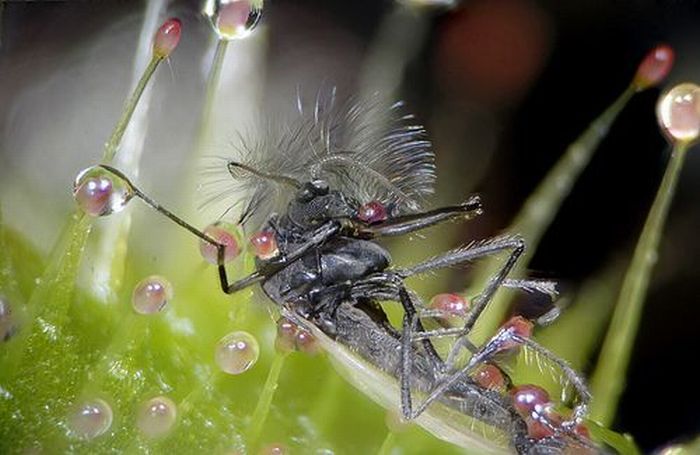
Carnivorous plants can be divided into active and passive predators. In the first, the traps are closed (Venus flytrap, Aldrovanda, pemphigus, Genlisea). In the second, the traps are static - nepenthes, zhyryanka, sarracenia, darlingtonia.
Digestion of protein foods is due to organic acids and digestive enzymes (pepsin), which are produced by plant cells. After the external breakdown of proteins, amino acids and mineral elements are absorbed by the plant.
Note: sensory hairs on plant leaves are so developed that they can distinguish living from non-living. Sundew and Venus flytrap do not react if a drop of water or a piece of bark falls on the leaves of the trap.
All carnivorous plants are angiosperms, and accordingly, they can bloom. Most of these plants have small, white or light pink flowers. But there are also representatives bright colors: genlisea (blue and purple), biblis (purple, lilac, blue, white).
Growing conditions
Of more than 600 species of carnivorous plants, only a couple dozen are cultivated as carnivorous houseplants. The most popular types are:
- nepenthes (some species);
- sundew (round-leaved, royal, English);
- Sarracenia purpurea and varieties based on this species;
- Venus flytrap;
- pemphigus (aquatic or semi-aquatic plant, can take root);
- Aldrovanda (aquatic, free-floating plant).
Nepenthes Rosyanka Zhyryanka Sarracenia purpurea Venus flytrap Heliamphora
Lighting
All carnivorous plants need good lighting, most of them are not afraid of even direct sunlight. With a lack of lighting, plants whose leaves are red, orange, burgundy, crimson in color become green, losing their decorative effect and brightness. The same applies to morphologically modified leaves intended for hunting: funnels, jugs, traps.
Particularly sensitive to lack of lighting are tropical representatives of hunter plants - Nepenthes, Darlingtonia.
AT winter period tropical plants need additional lighting.
Temperature
The temperature regime required by plants depends on the species and on the temperature in natural habitats. Representatives of the flora from the temperate climate zone- sundews, butterflies, venus flytrap, sarracenia - feel good at a temperature of 18-22 degrees. At the same time, they do not suffer at all when the temperature drops to 10-12. And they can even endure adverse conditions when the thermometer drops below 0.
Note: sundew, siryanka and frost-resistant varieties of sarracenia can be grown in open field near artificial reservoirs.
A typical representative of tropical hunter plants, Nepenthes, needs high temperature- from 22 and above.
substrate
The soil for predatory indoor plants should be similar to the composition of natural soil. The substrate should be acidic, with a pH of 5.0-6.2, and not contain many organic and mineral components. Alternatively, you can use a mixture of sphagnum peat with sand (3:1, or 2:1). Peat can be replaced with coconut fiber, and sand with perlite.
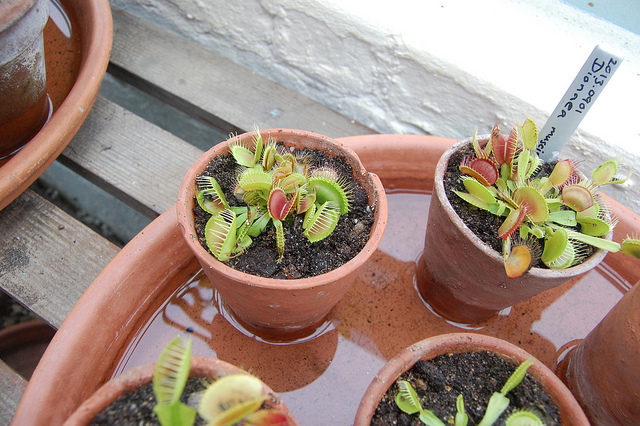
Humidity and watering
Watering carnivorous plants should be soft warm water(19-22 degrees). In the summer, the frequency of watering 2-3 times a week, in winter time, or when the temperature drops, watering is reduced to 1-2 times a week.
The most a big problem when growing insectivorous plants at home - providing the necessary air humidity. For their normal growth and vital activity, air humidity must exceed 60%. Ideally, for topical species such as Nepenthes, Venus Flytrap, Darlingtonia, the humidity should be 80-85%. Otherwise, the plant will eventually lose its zest: the ends of the leaves, on which the jugs and traps are located, will gradually dry out, and will not form on new leaves.
To maintain the required humidity, it is not enough to regularly spray the plant. You can use a tray in which to pour expanded clay or pebbles and pour water so that it does not touch the bottom of the container with the flower. The ideal option is to grow carnivorous plants in terrariums or winter gardens. Special air humidifiers designed to create a microclimate in places where houseplants- Another good option to solve the problem of air humidity.
Feeding and fertilizer

Green predators in indoor floriculture, as well as in nature, should receive additional food.
Fertilize carnivorous plants no more than 2 times a month (during the active growing season), stop fertilizing during the dormant period. As fertilizers, you can use standard liquid mineral components, which need to be diluted 5-6 times more than for ordinary plants.
Predators are fed, as expected, with protein food. For this purpose, ordinary flies, horseflies, cockroaches, small slugs, spiders are suitable. When feeding active predators, such as the Venus flytrap, you need to take the insect with tweezers, carefully bring it to the open trap and release it. As soon as the insect touches the sensitive hairs on the surface of the leaf, the trap will immediately close.
Feeding passive predators is not so exciting: the insect is simply lowered into a jug.
Rosyanka, zhyryanka, dewdrop...) are specially adapted for catching and digesting small animals, mainly insects, the size of which varies from microscopic daphnia to houseflies and wasps. Other animals, such as frogs and even small mammals, can sometimes be caught in the trapping devices of large plant species. Different types of Nepenthes catch termites or ants. Typically, such carnivorous plants live in places depleted in nitrogen, and insects are used as an additional source of nitrogen, thus obtaining additional nutrients by catching live prey.
All predatory plants feed on the substances that they draw from the soil. These substances are necessary for them to live normally. But many of them grow on such poor soils (swamps, deserts) that they lack the nutrients extracted from the earth. But how then to get the mineral salts necessary for life? They got out of the situation here and began to catch insects. Predatory plants can do without animal food, but this makes them lethargic, not very viable.
In total, about 630 species of insectivorous predatory plants are known. They range from sundew leaves with a sticky surface and the size of a fingernail thumb to huge trapping jugs of Nepenthes and the smallest trapping vesicles of pemphigus, and all of them are designed to trap and digest prey. Some predatory plants use digestive enzymes to digest their prey. Part of the plants, which are called semi-insectivorous, need the help of other organisms to digest the prey caught by the plants.
One such plant of predators is round-leaved sundew. This is one of rare representatives similar plants growing in Europe, since most of them live in the tropics or subtropics. She can be found in middle lane Russia. Sundew grows mainly in swamps. They were found in wet steppes and swamps, mostly on acidic soils, with a deficiency of minerals.
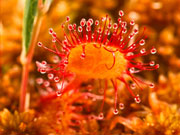 Rosyanka is a low herbaceous plant, the leaves of which are seated with many long red cilia (about 30 on each sheet). At the tips of these cilia are droplets of sticky juice of a special composition. Exhaling the smell of rot, it uses these cilia in order to capture the insect with them. Some fly sits on a leaf to taste the sweetish droplets, but is smeared with juice and can no longer fly away. The insect tries to free itself, but it almost never succeeds: the leaf curls up around it and begins to secrete a liquid similar in composition to digestive juice. It dissolves the fly, and when the leaf opens, only a miserable remnant remains of the insect. Soon the wind will blow them away or the rain will wash them away. The role of a trap is played by each individual sundew leaf only 3-4 times, after which it dries up and falls off.
Rosyanka is a low herbaceous plant, the leaves of which are seated with many long red cilia (about 30 on each sheet). At the tips of these cilia are droplets of sticky juice of a special composition. Exhaling the smell of rot, it uses these cilia in order to capture the insect with them. Some fly sits on a leaf to taste the sweetish droplets, but is smeared with juice and can no longer fly away. The insect tries to free itself, but it almost never succeeds: the leaf curls up around it and begins to secrete a liquid similar in composition to digestive juice. It dissolves the fly, and when the leaf opens, only a miserable remnant remains of the insect. Soon the wind will blow them away or the rain will wash them away. The role of a trap is played by each individual sundew leaf only 3-4 times, after which it dries up and falls off.
The venus flytrap is also a carnivorous plant. It can be found in western North America. Its leaf has the shape of an open shell. There are hairs on the outer side of the leaf. It is enough for an insect to touch the hairs on both sides in order for the leaf to close. An insect that touches only one side of the leaf is out of danger, it can safely feast on nectar. But when the future victim touches the hairs on both sides of the leaf, the mousetrap slams shut: the insect is in the “cage”. And it slams shut because special cells begin to intensively divide - and the trap works. Inside the “flycatcher”, special secrets are released that process the insect to liquid state. Charles Darwin was very interested in the properties of this carnivorous plant. So, he conducted an experiment and found out that the hairs of a flycatcher cannot distinguish a drop of rain or a breath of wind from an approaching insect, and its “shutters” often slam shut in vain. But on the other hand, digestive enzymes are released only when there is a victim in the “cage”. Now the flycatcher has been included in the Red Book, because due to the mass collection, its number has sharply decreased. Many have used it as a fly repellant. The cut leaves were planted in a flower pot and, if the predatory plant took root, not a single fly remained in the house.
In pemphigus, which lives in swamps, some of the leaves have changed - they have become like small bubbles. Each such bubble has a very tricky structure: small prey (daphnia, mosquito larvae, etc.) are sucked into it, as it were, through a funnel. Moreover, it is quite difficult to get out of such a trap: a special valve prevents this. A small crustacean falls into such a “whirlpool” and is trapped. And then the script...
Zhiryanka lives in the forest-tundra. Attracting insects with color, smell or sweet secretions, predator plants catch them in one way or another, and then release enzymes into the trap that digest the caught prey. The products formed as a result of such extracellular digestion, mainly amino acids, are absorbed and assimilated.
Some predatory plants do not secrete digestive juice. The prey in them simply rots, and the decomposition products are used as nutrients. An example is darlingtonia california, whose large white flowers lure insects with their sight and smell.
 In some carnivorous plants (sunflower, oilseed, rosolith, etc.), the leaves are covered with numerous glands that secrete a sticky transparent liquid that attracts insects and sticks them to the leaf. When an insect falls into a trap, the secretions from the glands intensify in a predatory plant; at the same time, the glandular hairs bend towards the body of the insect (sundew) or the edges of the trapping leaf on which it is located (syryanka) are wrapped. In other predatory plants, the trapping apparatus is represented either by passively trapping insects (nepenthes, sarracenia, darlingtonia, etc.) or by active traps (dyonea, aldrovandus, pemphigus, etc.).
In some carnivorous plants (sunflower, oilseed, rosolith, etc.), the leaves are covered with numerous glands that secrete a sticky transparent liquid that attracts insects and sticks them to the leaf. When an insect falls into a trap, the secretions from the glands intensify in a predatory plant; at the same time, the glandular hairs bend towards the body of the insect (sundew) or the edges of the trapping leaf on which it is located (syryanka) are wrapped. In other predatory plants, the trapping apparatus is represented either by passively trapping insects (nepenthes, sarracenia, darlingtonia, etc.) or by active traps (dyonea, aldrovandus, pemphigus, etc.).
Swamp liana nepenthes, growing in the tropical forests of South Asia, is a predatory plant with many small multi-colored flowers that resemble a jug in shape. Inside the flower are drops of fragrant nectar. Insects hoping to feast on sweet juice climb inside the flower. The inner walls of the flower are covered with a special wax coating, so that the insect slides down. Sharp cilia do not allow him to get out, which do not prevent the penetration of the insect inside, as they are smoothed to the side surface of the flower. But when the inner cilia sense the victim's vibration, they rise up and block the victim's path. The insect is trapped. Another secret of this predatory plant is that the sweet aroma that attracts the insect turns out to be digestive juice. After a few hours, only the undigested skin remains from the insect, which will remain in the flower.
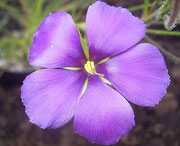 Another insectivorous predatory plant - giant biblis - is a low shrub with frequent sticky narrow leaves. It is they who become the “murder tools”, releasing the digestive juice. The glue on these leaves is so strong that, in addition to insects, frogs and even small birds often become victims of this plant! The inhabitants of Australia (this is where these predatory plants can be found) used Byblis leaves as glue or adhesive tape.
Another insectivorous predatory plant - giant biblis - is a low shrub with frequent sticky narrow leaves. It is they who become the “murder tools”, releasing the digestive juice. The glue on these leaves is so strong that, in addition to insects, frogs and even small birds often become victims of this plant! The inhabitants of Australia (this is where these predatory plants can be found) used Byblis leaves as glue or adhesive tape.
In ancient times, many peoples composed legends about the so-called cannibal plants. As if there were witnesses to how a giant plant devoured a person, leaving only a bare skeleton. Several times, indeed, the remains of people were found near plants, which were suspected of cannibalism. According to one version, the plant strangled a person with the help of leaves and a soporific smell and sucked out all the nutrients from him. It should be noted that scientists are skeptical about the rumors about the existence of such plants of predators.
Everyone knows that plants feed on substances removed from the soil (or other plants), they need water, light and - most of them - heat. Many people also know about a flower that eats flies, and for some reason the majority are afraid of it, considering it almost a monster. Meanwhile, predatory plants are simply living organisms, placed by nature in such conditions that they had to survive in a non-standard way. Rather, they deserve respect for their vitality and perseverance in evolution. Strictly speaking, flowers that eat flies are on the same level, for example, with tigers, which are also by no means vegetarians. And besides, most of the plant predators are amazingly beautiful.
Why did predatory plants appear?
In order to become, we had to work hard and grow additional organs and glands in the course of evolution to produce the necessary enzymes. Without such a set, not a single plant could catch, hold and digest an insect. To maintain the efficiency of this complex system, a flower that eats flies spends great amount forces. Scientists believe that carnivory becomes justified only when the plant lives in a completely certain conditions, because some insectivorous flowers even lost the ability to photosynthesis for the sake of their trapping organs. Such circumstances are soils poor in phosphorus and nitrogen. In other words, swamps. No wonder everyone comes from such areas. Loss " solar panels"In this case, it is quite understandable: the plants do not shade, and they have enough of the light that meager leaves produce. 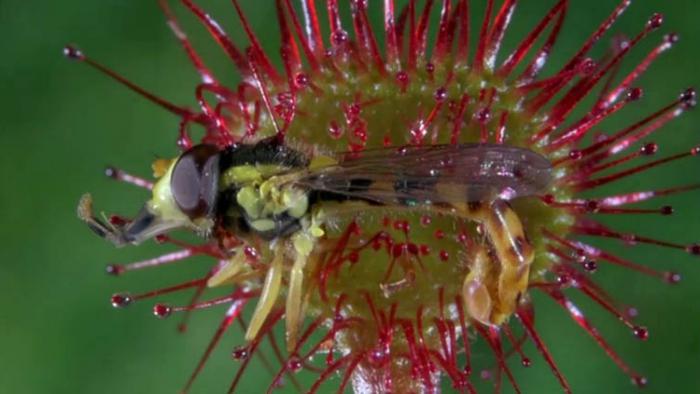
Vulnerability of plant predators
The life of a flower that eats flies is not so simple in itself. An insect, not too successfully and firmly grasped, is quite able to escape from the trap. And even if it dies afterwards, the plant predator will remain hungry. Plus the realities of civilization: in modern world it is precisely those qualities that have been developed over millennia that can destroy flowers that eat flies. Nitrogen fertilizers washed from the fields and discharged from power plants are oversaturated with nitrogen, which kills plant predators. The second threat they cannot defend against is poaching. Growing up in last years the demand for it encourages adventurers to seek out wild venus flytraps and sell them almost on the side of the road. Those copies that remained "in the hands" of sellers are indifferently thrown away. In addition to all these troubles, the result of land development is the disappearance of the habitat of predatory flowers. So, it is quite possible that in the next half century they will remain only in greenhouses and home collections. 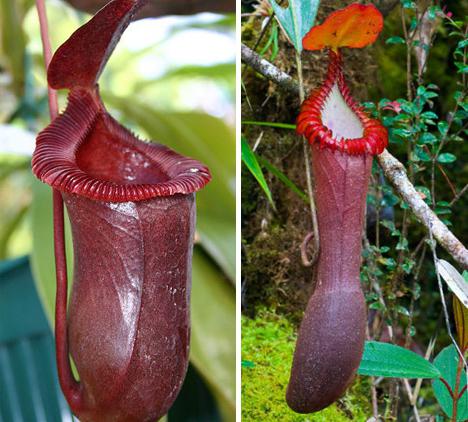
Sundew's trappings
In the vastness of our country, almost everyone knows only one flower that eats flies. It bears the name "dew". It is amazing beautiful plant, pubescent with fine hairs that end in droplets of sticky secretions. Insects mistake them for water; an additional incentive to their approach is the aroma of sundew. When the midge is firmly stuck, the leaf begins to slowly curl up. Already in a folded state, he digests his prey.
How does a fat lady hunt?
Another flower that eats flies and is found in the Russian expanses is zhiryanka. She received a not very euphonious name for the mucus with which the leaves are covered. Thanks to it, the surface gleams, as if greased. The mechanism of attracting insects is by smell, the method of use is similar to how the sundew assimilates the victim. Only the leaf does not fold: it is covered with digestive glands. So as soon as the mosquito sticks, it immediately begins to be absorbed. 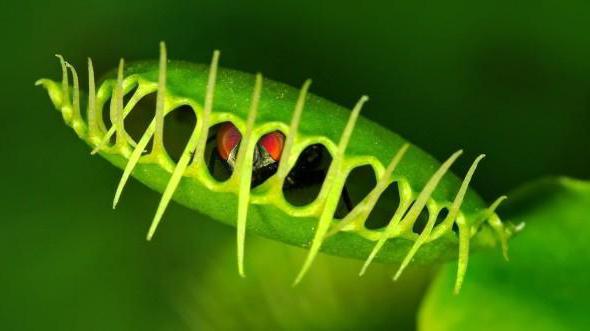
Venus flytrap (Dionea)
It is because of its method of hunting that this flower, which eats flies, is a tasty prey for a poacher. No other predatory plant closes the trap, and moreover, so effectively. Considering that the leaves are equipped with cloves along the edge, the hunt looks like a trap slammed shut or wolf teeth snapped. Again, the process of digestion is hidden, in contrast to the same butterwort, so that nervous observers are spared from observing the "torment" of the insect and the need to sympathize with it. All these features have made the flycatcher a desirable pet for many indoor growers. There is a very large number of those who want to boast that a flower that eats flies lives on their windowsill. The price stops some, but it cannot be said that it is so excessive. On average, in specialized stores for a Venus flytrap, they ask for 600 rubles; however, small copies can be bought for three times cheaper.
By the way, you can buy not only Dionea from predator plants. Nepenthes, and sarracenia, and sundews, and other carnivorous flowers are on sale - in the same price range.
These amazing plants are carnivorous as they trap insects and arthropods, secrete digestive juices, dissolve their prey, and in the process obtain some or most of their nutrients. Almost all carnivorous plants grow in places where the soil is poor in nutrients.
Here are the most famous carnivorous plants that use different types traps to lure their prey.
1. Sarracenia
Sarracenia or North American carnivorous plant is a genus of carnivorous plants that are found in areas of the east coast of North America, in Texas, in the Great Lakes, in southeastern Canada, but most are found only in the southeastern states.
This plant uses water lily-shaped traps as a trap. The leaves of the plant have developed into a funnel with a hood-like formation that grows over the opening, preventing rainwater from entering, which can dilute digestive juices. Insects are attracted to color, smell, and secretions like nectar at the edge of a water lily. slippery surface and narcotic substance, bordering the nectar, encourage insects to fall inside, where they die and are digested by protease and other enzymes.
2. Nepenthes
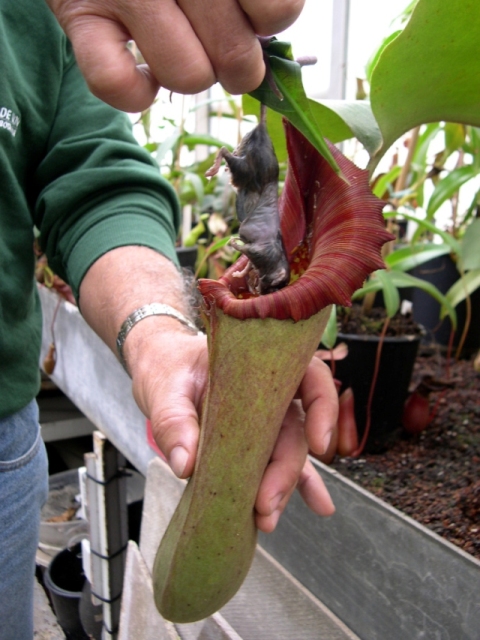
Nepenthes, a tropical insectivorous plant, is another species of carnivorous plant with a trap that uses water lily-shaped trapping leaves. There are about 130 species of these plants, which are widely distributed in China, Malaysia, Indonesia, the Philippines, Madagascar, Seychelles, Australia, India, Borneo and Sumatra. This plant has also earned the nickname "monkey cup" as researchers often observed monkeys drinking rainwater from them.
Most types of Nepenthes are tall vines, about 10-15 meters, with a shallow root system. Leaves are often visible from the stem, with a tendril that protrudes from the tip of the leaf and is often used for climbing. At the end of the tendril, the water lily forms a small vessel, which then expands to form a cup.
The trap contains a liquid secreted by the plant, which may have a watery or sticky texture, and in which the insects eaten by the plant drown. The bottom of the bowl contains glands that absorb and distribute nutrients. Most of plants are small and only catch insects, but large species such as Nepenthes Rafflesiana and Nepenthes Rajah can catch small mammals such as rats.
3. Carnivorous plant Genlisea (Genlisea)
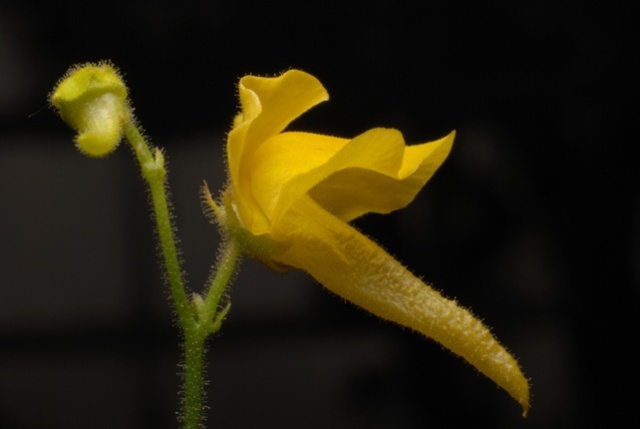
Genlisea consists of 21 species, usually grows in humid terrestrial and semi-aquatic environments and is distributed in Africa and Central and South America.
Genlisea is a small herb with yellow flowers that use a crab claw-type trap. Such traps are easy to get into, but impossible to get out of because of the small hairs that grow towards the entrance or, as in this case, forward in a spiral.
These plants have two various types leaves: photosynthetic leaves above ground and special underground leaves that lure, trap and digest small organisms such as protozoa. The underground leaves also perform the role of roots, such as water absorption and attachment, since the plant itself does not have them. These underground leaves underground form hollow tubes that look like a spiral. Small microbes get into these tubes with the help of a stream of water, but cannot get out of them. By the time they get to the exit, they will already be overcooked.
4. Darlingtonia California (Darlingtonia Californica)

darlingtonia california is the only member of the genus Darlingtonia that grows in northern California and Oregon. It grows in swamps and springs with cold running water and is considered a rare plant.
Darlingtonia leaves are bulbous in shape and form a cavity with a hole under the swollen like Balloon, structure and two sharp sheets that hang down like fangs.
Unlike many carnivorous plants, it does not use trapping leaves to trap, but uses a crab claw-type trap. Once the insect is inside, they are confused by the specks of light that pass through the plant. They land in thousands of dense, fine hairs that grow inwards. Insects can follow hairs deep into digestive organs but cannot go back.
5. Pemphigus (Utricularia)
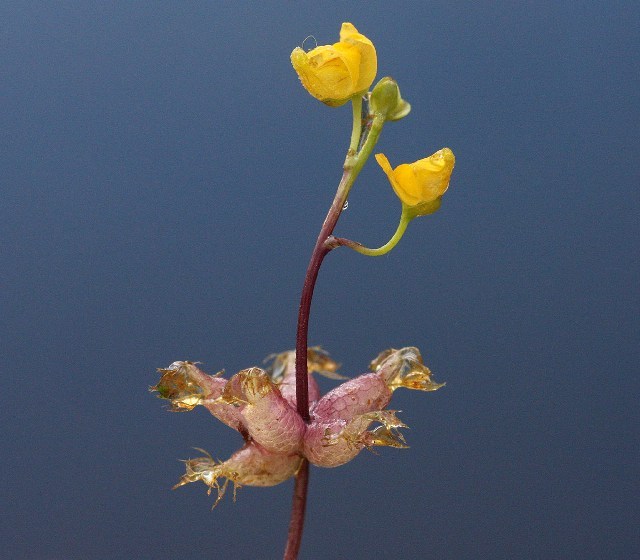
Bladderwort is a genus of carnivorous plants with 220 species. They meet in fresh water or wet soil as terrestrial or aquatic species on all continents except Antarctica.
They are the only carnivorous plants that use the bubble trap. Most species have very small traps in which they can catch very small prey such as protozoa. Traps range from 0.2 mm to 1.2 cm, and larger prey, such as water fleas or tadpoles, fall into large traps.
The bubbles are under negative pressure with respect to the surrounding stop. The opening of the trap opens, sucks in the insect and surrounding water, closes the valve, and all this happens in thousandths of a second.
6. Zhiryanka (Pinguicula)
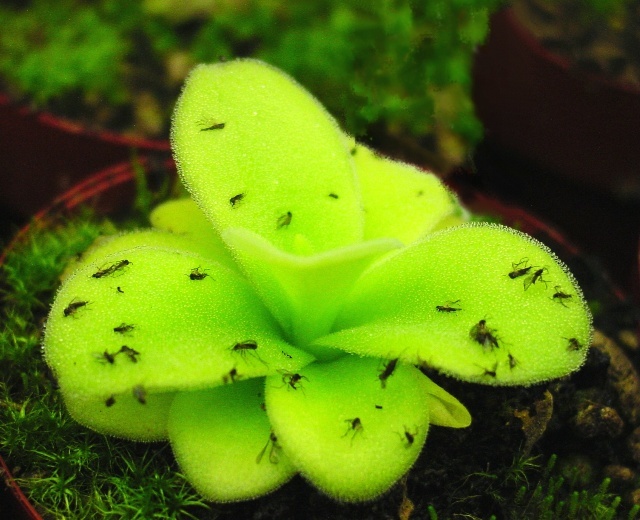
Oilwort belongs to a group of carnivorous plants that use sticky, glandular leaves to lure and digest insects. Nutrients obtained from insects supplement the soil, which is poor in minerals. There are approximately 80 species of these plants in North and South America, Europe and Asia.
The leaves of the buttercup are succulent and usually have a bright green or pink color. There are two special types of cells found on the upper side of the leaves. One is known as the peduncle and is made up of secretory cells at the top of a single stem cell. These cells produce a slimy secretion that forms visible droplets on the surface of the leaves and acts like Velcro. Other cells are called sessile glands, and they are found on the surface of the leaf, producing enzymes such as amylase, protease, and esterase, which aid in the digestive process. While many species of butterwort are carnivorous all year round, many types form a dense winter rosette that is not carnivorous. When summer comes, it blooms and has new carnivorous leaves.
7. Sundew (Drosera)

Rosyanka is one of the largest genera of carnivorous plants, having, according to at least, 194 species. They are found on every continent except Antarctica. Sundew can form basal or vertical rosettes from 1 cm to 1 m in height and can live up to 50 years.
Sundews are characterized by moving glandular tentacles topped with sweet, sticky secretions. When an insect lands on the sticky tentacles, the plant begins to move the rest of the tentacles in the direction of the victim in order to further drive it into a trap. Once the insect is trapped, small sessile glands absorb it and the nutrients go to plant growth.
8. Byblis
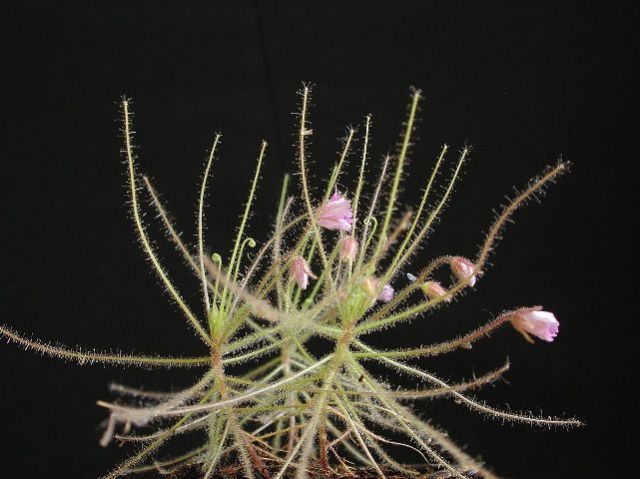
Byblis or rainbow plant it is a small species of carnivorous plant native to Australia. The rainbow plant gets its name from the attractive slime that coats the leaves in the sun. Despite the fact that these plants are similar to sundews, they are not related to the latter in any way and are distinguished by zygomorphic flowers with five curved stamens.
Its leaves have a round section, and most often they are elongated and conical at the end. The surface of the leaves is completely covered with glandular hairs, which secrete a sticky mucous substance that serves as a trap for small insects that land on the leaves or tentacles of the plant.
9. Aldrovanda vesiculosa (Aldrovanda vesiculosa)
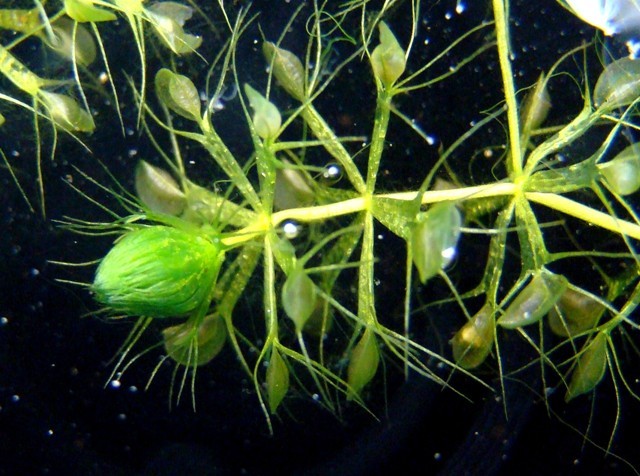
Aldrovanda vesicularis is a magnificent rootless, carnivorous aquatic plant. It usually feeds on small aquatic vertebrates using a trap trap.
The plant consists mainly of free-floating stems that reach 6-11 cm in length. Leaves-traps, 2-3 mm in size, grow in 5-9 curls in the center of the stem. The traps are attached to the petioles, which contain air that allows the plant to float. It is a fast growing plant and can reach 4-9mm per day and in some cases produce a new curl every day. While the plant grows at one end, the other end gradually dies.
The plant trap consists of two lobes that close like a trap. The holes of the trap are directed outward and covered with fine hairs that allow the trap to close around any prey that comes close enough. The trap closes in tens of milliseconds, which is one example of the most fast movement in the animal world.
10. Venus flytrap (Dionaea Muscipula)
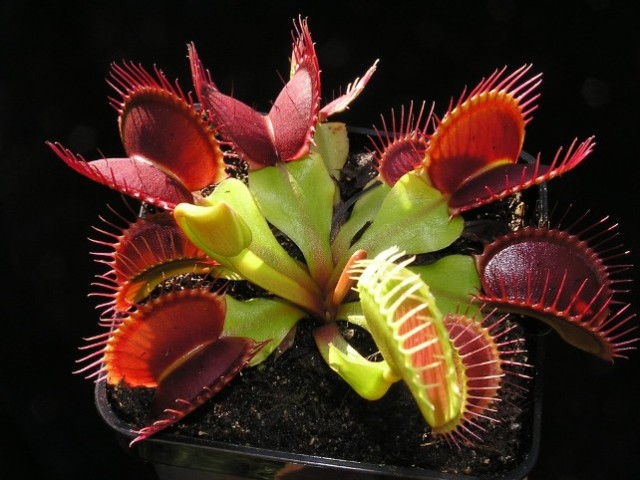
Venus flytrap, perhaps the best-known carnivorous plant that feeds mainly on insects and arachnids. It is a small plant with 4-7 leaves that grow from a short underground stem.
The leaf blade is divided into two regions: flat, long, heart-shaped petioles capable of photosynthesis and a pair of terminal lobes hanging from the main vein of the leaf, which form a trap. The inner surface of these lobes contains a red pigment, and the edges secrete mucus.
Dionaea muscipula vs Caterpillar
The leaf lobes make a snapping motion, slamming shut when its sensory hairs are stimulated. The plant is so developed that it can distinguish a living stimulus from a non-living stimulus. Its leaves slam shut in 0.1 second. They are lined with cilia that are as hard as spikes and hold their prey. As soon as the prey is caught, the inner surface of the leaves is gradually stimulated, and the edges of the lobes grow and merge, closing the trap and creating a closed stomach, where the prey is digested.








